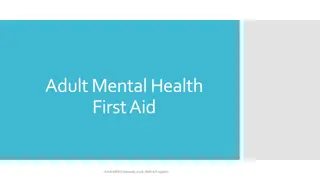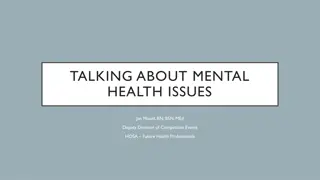
Overcoming Barriers to Insurance Coverage: A Role for Advocacy
Explore the challenges faced in obtaining insurance coverage and the significance of advocacy in overcoming these barriers. From understanding insurance policies to resolving disputes, discover strategies to ensure access to necessary healthcare services.
Download Presentation

Please find below an Image/Link to download the presentation.
The content on the website is provided AS IS for your information and personal use only. It may not be sold, licensed, or shared on other websites without obtaining consent from the author. If you encounter any issues during the download, it is possible that the publisher has removed the file from their server.
You are allowed to download the files provided on this website for personal or commercial use, subject to the condition that they are used lawfully. All files are the property of their respective owners.
The content on the website is provided AS IS for your information and personal use only. It may not be sold, licensed, or shared on other websites without obtaining consent from the author.
E N D
Presentation Transcript
Overcoming Barriers to Overcoming Barriers to Insurance Coverage: Insurance Coverage: A Role for Advocacy A Role for Advocacy 1
Claims paid Identify appropriate clinician Understand insurance coverage Progress with treatment Resolve any disputes 2
At Least I Have Health Insurance Denials are significant Denials are confounding Absence of an in-network clinician is not an actionable denial Appeals are extremely rare Litigation is extremely challenging Federal regulatory enforcement is constrained 3
Patient Expectations Clinician(s) with relevant expertise identified in network directory Clinician close to home Identify Appropriate Clinician Appointment available soon Insurer support: Easy-to-use, up-to-date directory Live customer service help, as needed 4
Patient Expectations Understand insurance coverage No surprises Clinician has most timely, specific information for treatment decision-making Progress with treatment Treatment plan will: Provide optimal support for patient Minimize potential risks For required duration 5
Clinical training, practice Insurer standard Do no harm. Medical necessity Safe and effective Generally accepted standards 6
Medical Necessity Letters This letter describes my clinical assessment and the medically necessary treatment for [patient]. I have been treating [patient] since approximately [date] and am certifying that this level of care is medically necessary. Clinician credentials and practice Summary clinical assessment: o Patient relationship o Patient presentation Generally accepted standards of care: o Which standards o How the standards were applied Medically-necessary course of treatment 7
Medical Necessity Letters When? Clinical Occasions Examples intensive outpatient (IOP) residential care Change in level of care, such as transition to/from: partial hospitalization (PHP) in-patient care Notable progress (or reversal) Update in patient status or clinical decision-making New or modified treatment plan Insurer requires a lower level of care (aka step therapy or fail first ) Following notice of denied claim or course of treatment Insurers may deny as experimental a treatment accepted by the mainstream medical community Insurer inquiry regarding appointment frequency Insurer s suggestion of a different medication inconsistent with clinician s determination Medication change to Rx with known denial risk by insurer At time of prior authorization Prior authorization Reversal of prior authorization 8
Determining Dosage of Therapy Informed by the robust literature of clinical research, generally accepted standards of care provide guidance for appropriate frequency and duration of out-patient therapy carefully prescribed as appropriate to the patient's specific clinical condition. Such decision-making is among the most critical responsibilities of a clinician, whether a psychiatrist, psychotherapist, psychologist or LCSW. Susan G Lazar, MD George Washington University School of Medicine 9
Cover My Mental Health Resources Potential advanced steps Formal insurer complaint Request for complete claims file Constituent services support Regulator complaint Claims paid Resolve any disputes Formal appeal External review, if initial appeal fails Single case agreement Lawsuit 10
Formal Insurer Complaint THE FOUR THINGS TO SAY TO AN INSURER CUSTOMER SERVICE REP: 1. I want to file a formal complaint. ( NOT an appeal.) 2. This formal complaint is for a quality- of-care failure and a potential breach of contract. 3. The quality-of-care failure is [explain your issue here] ; 4. I expect resolution of this formal complaint within 3 business days or 72 hours. Absent resolution, I may file a complaint with the state insurance regulator. 11
Key Takeaways www.covermymentalhealth.org encouragement and resources Medical necessity letters assert a clinician s primacy for a patient s treatment and for the insurer s coverage Appeals hardly the only path to dispute resolution Follow-up actions available if at first, you don t succeed 12
Joe Feldman joe@covermymentalhealth.com 312.961.2099 President, Cover My Mental Health* Please share your feedback with our 3-question survey www.covermymentalhealth.org 13 * Not-for-profit Illinois corporation; IRS-confirmed tax-exempt status






















